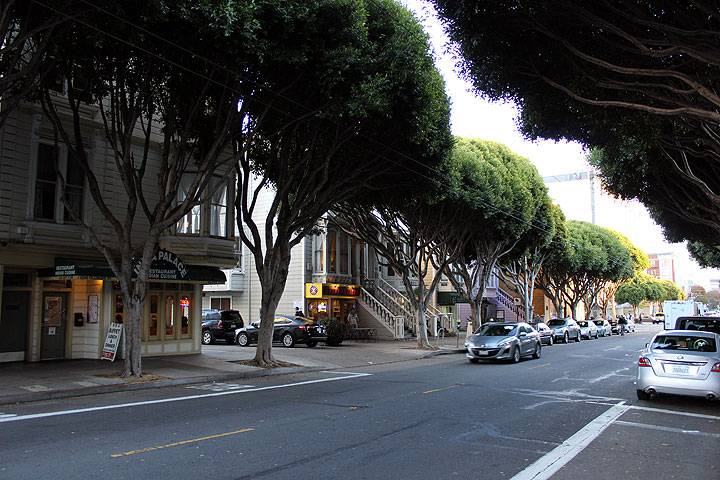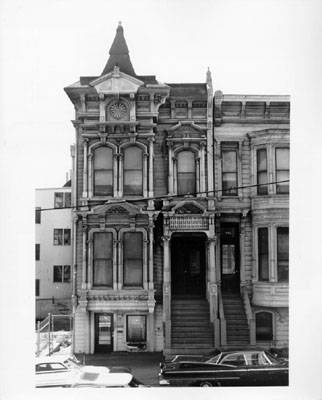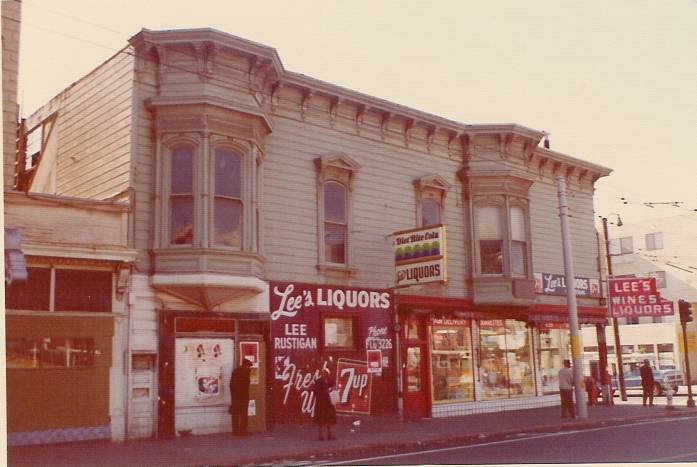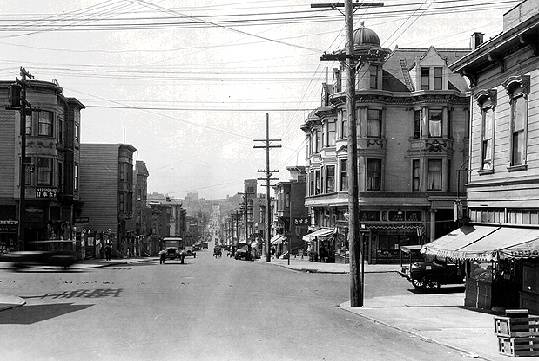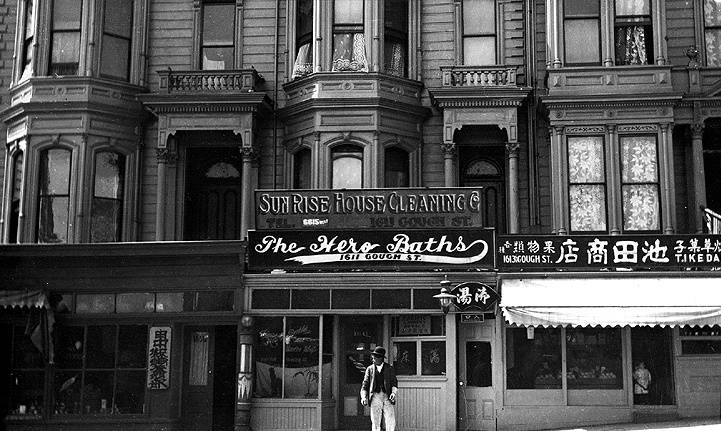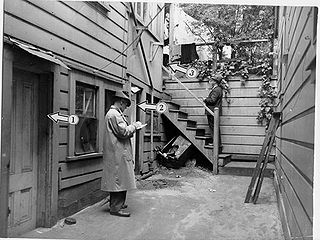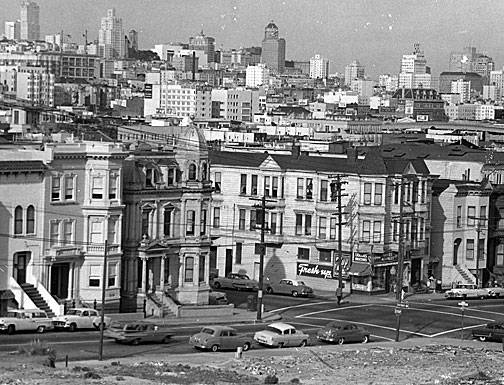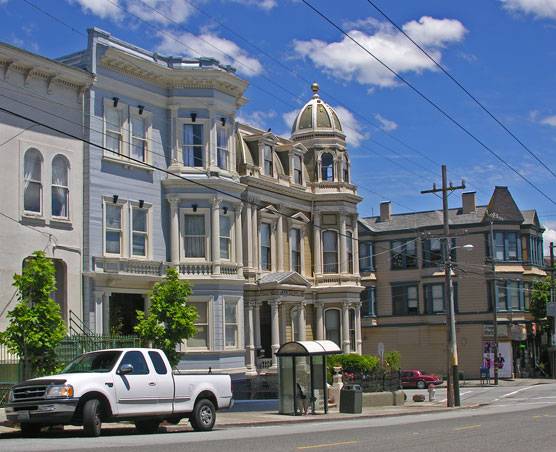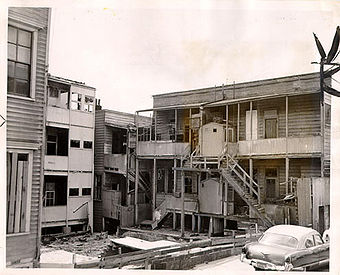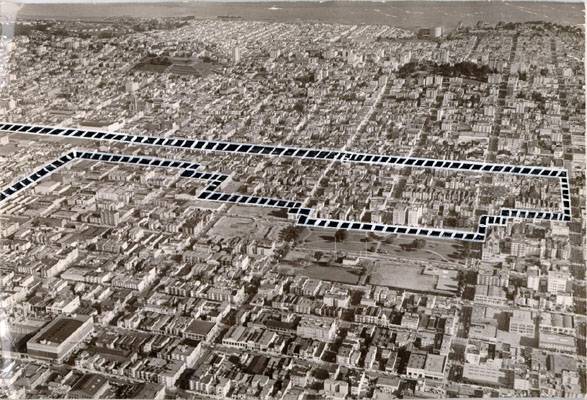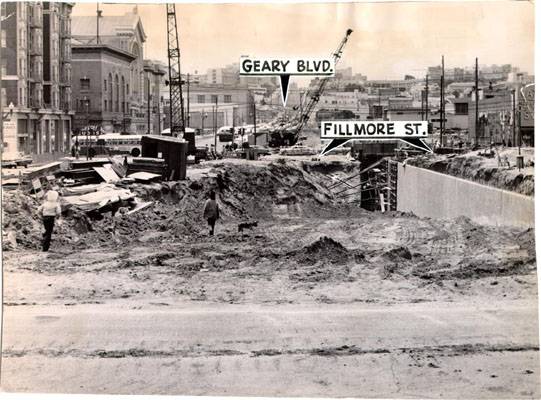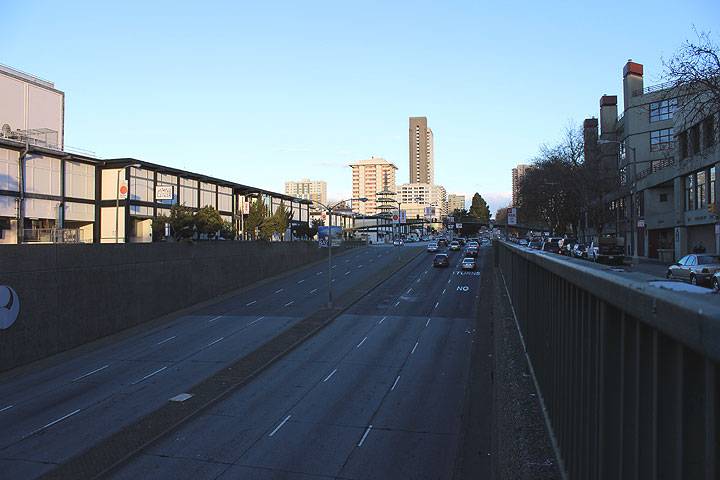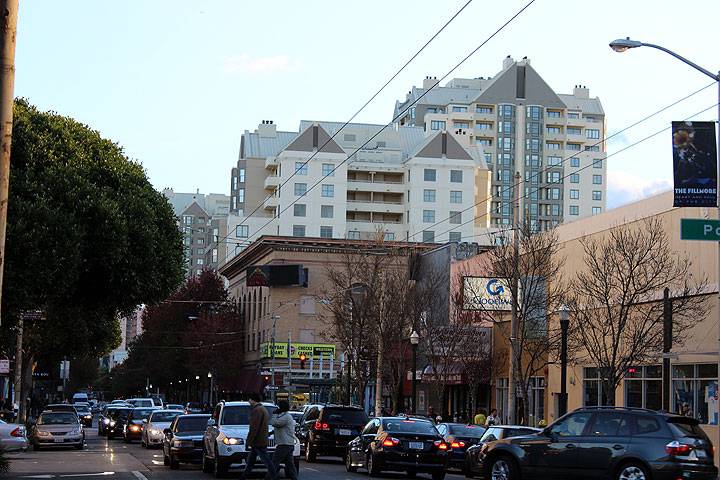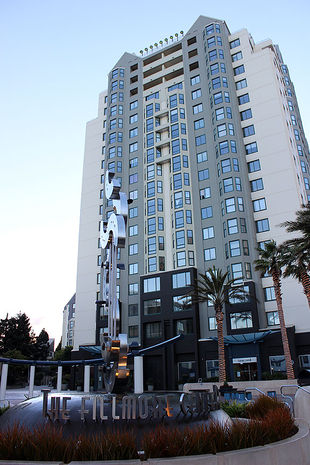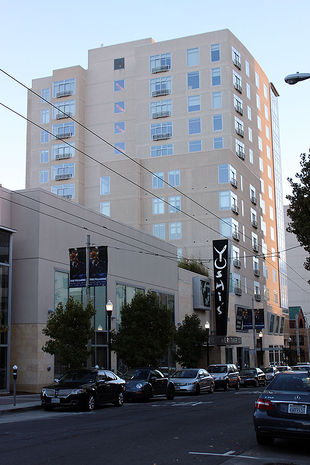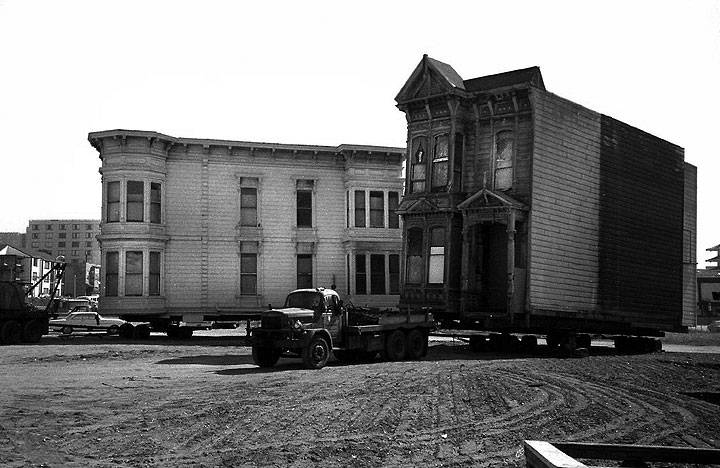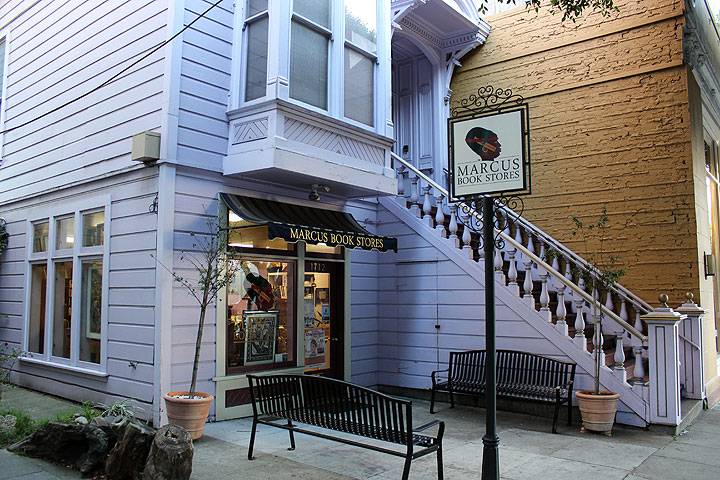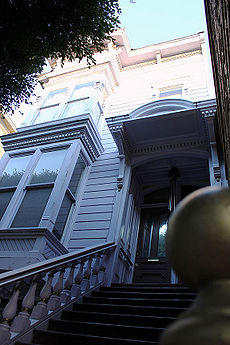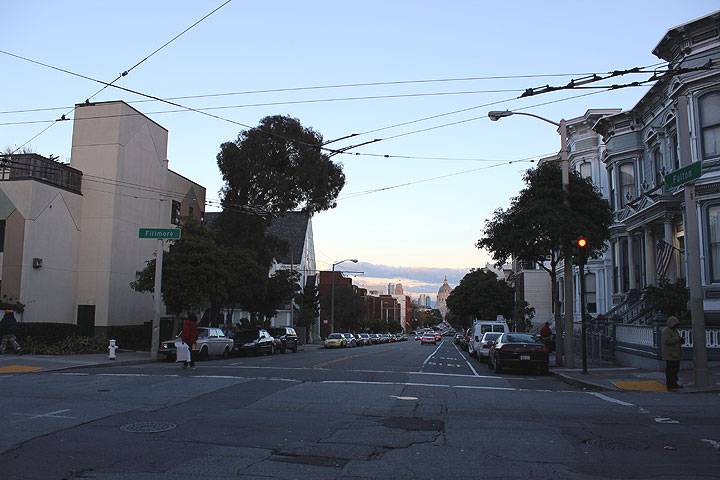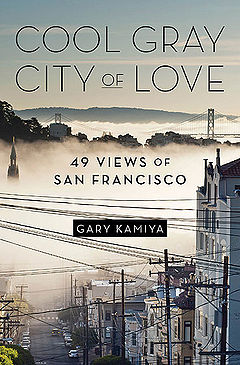Western Addition: A Basic History
Historical Essay
© By Gary Kamiya, excerpted with permission (see bottom for more info). Originally this chapter was titled "The Haunted House".
The block of Fillmore Street between Post and Sutter, as described below.
Photo: Chris Carlsson, 2013
A geologist would call the block of Fillmore Street between Post and Sutter a “triple junction.” It’s one of those three-way collisions where a swanky part of town crashes into a seedy one, while a completely different quarter sideswipes both of them. In 1974, my cousin Jonathan and I were house-sitting four blocks away, at Pine and Buchanan, in a majestic, decaying Victorian with a big psychedelic mandala painted in an alcove.
1737 Webster Street, c. 1974
Photo: San Francisco History Center, San Francisco Public Library
We didn’t know it at the time, but our building was a weird precursor to the Summer of Love. In 1965, that stretch of Pine Street had been a pre-Haight hippie scene, with half a dozen houses filled with longhairs and dealers. The downstairs unit had been home to the legendary hippie newspaper the Oracle. Across the street, at 2111 Pine, a rooming house once stood; some of the itinerant musicians there played in a vanished after-hours jazz club three blocks away called Bop City. The rooming house was managed by a guy named Bill Ham, who invented psychedelic light shows.
Our block was mostly black and pretty run-down. We used to walk down to Kim’s Market at Pine and Fillmore (now a Kiehl’s, which sells $50 bottles of shampoo) to buy our daily $2 ration of sausages, carrots, and potatoes. If you turned right on Fillmore, in a block you would come to California Street, the city’s great north-south dividing line. California was and is the unofficial border of Pacific Heights, the swankiest neighborhood in town. Turn left and you would quickly end up in the unswankiest neighborhood in town.
Past Kim’s Market, as you walked toward Bush, the block was a grab bag, with a venerable Japanese restaurant rubbing shoulders with a jumping jazz and R&B joint called Minnie’s Can-Do Club. In the block after Bush, things started to become disheveled, a no-man’s-land traversed by Japanese, blacks, and a few confused tourists looking for Japantown. Once you crossed the ugly, multi-lane Geary Expressway, you were in the heart of black San Francisco.
Lee's Liquor Store at 1656-58 Fillmore Street, between Geary and Post, in early 1960s before Redevelopment bulldozed this block.
Photo: SFNative
Some years after I moved out of the neighborhood, I happened to find myself on Fillmore between Post and Sutter. I remember being subliminally aware that there was something odd about the east side of the street. Its feng shui was wrong. In particular, there was something weird about a row of five stately Victorians. But I couldn’t put my finger on it.
It took me a few decades, but I finally learned why that block felt off. Those five Victorians were not built there. They were saved from the wrecking ball, raised up from their original sites, and plunked down on Fillmore. The block felt weird because the setbacks were too deep.
It is appropriate that this line of Victorians stands out. For one of its buildings has a history so rich and strange that an entire book could be written about it. The house at 1712 Fillmore is San Francisco’s version of Joyce’s 7 Eccles Street. It is a universe on a 27 1/2-by-93-foot lot.
In or around 1895, a three-story Victorian, built in the exuberant Queen Anne style that was the last hurrah of Victorian architectural excess, was erected at 1690 Post Street, just east of Buchanan, in the Western Addition. The name Western Addition is a link with the Gold Rush days, when the city did not even include all of Nob Hill. In 1851, San Francisco’s western limit was Larkin Street, a few yards west of my house on Jackson. A year later, the booming city extended its boundary 13 blocks west to Divisadero.
The area north of Market Street between Larkin and Divisadero became known as the “Western Addition.” Despite the fact that the “addition” is now 160 years old, the name has stuck. A more suitable name, considering the way the city has treated the neighborhood and its residents, might be the “Western Subtraction.”
The Western Addition was a solidly middle-class and upper-middle-class neighborhood. Streetcar lines carried its merchants and professionals to their offices in downtown San Francisco. By 1900 its residents were mostly native born, three-quarters of them to immigrant parents from countries like Germany, Austria, Ireland, and France. A significant number of them were Jews, mostly from Germany, attracted by San Francisco’s lack of overt anti-Semitism and business opportunities. By the 1870s, Jews made up 7 to 8 percent of the city’s population, the highest percentage in any city west of New York.
The first of the neighborhood’s three great transformations was a result of the 1906 fire. Displaced working-class people from the burned-out downtown and South of Market areas poured in. The stately single-family Victorians were divided into rooms and flats. The neighborhood became more densely populated, poorer, and much more ethnically diverse. Large numbers of working-class Filipinos, Mexican Americans, and Jews moved in. So did the two ethnic groups whose fates would become entwined in the neighborhood, and in that wooden building on Post Street: African Americans and Japanese.
Blacks began arriving in San Francisco before the Gold Rush, but never in great numbers until World War II. As Albert Broussard notes in Black San Francisco: The Struggle for Racial Equality in the West, 1900–1954, the lack of factory jobs and the distance from the South discouraged black immigration, but so did the “politely racist” attitudes held by many white San Franciscans. The early city had no racial covenants for blacks and no ghettos, but it was only the fact that there were so few blacks that created the illusion of unusual tolerance: The white citizens of San Francisco shared many of the racial prejudices of their fellow white Americans. After 1906, increasing numbers of blacks moved into the Western Addition. By 1930, almost half of all the 5,000 blacks in the city lived in the neighborhood.
So did most of the Japanese. The first Japanese immigrants arrived in San Francisco in 1869, establishing the first and oldest Japantown in the United States. (One of the most influential early immigrants, a devout Christian and future newspaper editor named Kyutaro Abiko, established an agricultural colony of fellow Japanese in Livingston in the Central Valley, soon followed by a colony in Cortez, near Turlock. My Japanese grandparents emigrated to the Cortez colony in the early 1920s; my Nisei father was born in nearby Turlock in 1925.)
Post and Laguna Streets, 1927
Photo: San Francisco History Center, San Francisco Public Library
The first Japanese in San Francisco lived in South Park and on Dupont (Grant) in Chinatown. Like many other ethnic groups, they moved to the Western Addition after 1906. The willingness of the neighborhood’s landlords, many of them Jewish, to rent to Japanese did not sit well with many whites: In 1907, the Chronicle ran a scare piece about the Japanese “invasion” of the Western Addition titled “A Greater San Francisco or a Lesser Nagasaki— Which?”
The Western Addition was one of the most diverse neighborhoods in the country; writer Jerry Flamm calls it San Francisco’s “Little United Nations.” The Japanese population was a mixture of older, first-generation (Issei) immigrants, most of whom were not U.S. citizens, and their second-generation (Nisei) children, almost all of whom were citizens. For convenience, I will refer to them all as Japanese Americans.
At some point after the quake, the majestic Queen Anne Victorian at 1690 Post Street was divided into apartments. Sometime before 1920, the Nippon Drug Company opened on its ground floor. In 1930 the co-owner of Nippon Drugs was a man named J. Hatsuto Yamada, who lived eight blocks away at Bush and Divisadero.
Japantown, until WWII internment. Gough between Bush and Pine, c. 1933
Photo: Private Collection, San Francisco, CA
By 1940, more than 5,000 Japanese Americans were living in Japantown. There were more than 200 Japanese-owned businesses. Some owned property; the exact percentage is unclear. Many worked as domestic servants, the famous “Japanese house boys.”
Japantown on the eve of the war was a bustling enclave. It had 40 churches, 17 schools and kindergartens, a department store, and dozens of small businesses. Culturally, it was a scramble: There were four traditional baths but also American-style diners serving hot dogs, ham and egg sandwiches— and fried noodles.
Then came Pearl Harbor. After word got out, hostile whites drove through the neighborhood, staring creepily at its inhabitants. The authorities immediately began arresting “suspicious” Japanese. An incident reported in the December 9 Call-Bulletin reveals the round-up-the-usual-suspects nature of this early venture into Homeland Security. Under the headline “Enemy Aliens Arrested Here,” the paper gravely reported that three Japanese men had been arrested on suspicion of taking a photo of an army transport, “although no camera was found.”
“No camera was found” could have been the motto for the entire hysterical, fear-and-race-driven episode that followed. Californians in general and San Franciscans in particular had long viewed the Japanese as even worse—more ambitious, more evil, more underhanded—than the despised Chinese. Journalist and historian Carey McWilliams described the hostility as the “California-Japanese War.” In 1900 the San Francisco journal Organized Labor opined,
“Chinatown with its reeking filth and dirt, its gambling dens and obscene slave pens, its coolie labor and bloodthirsty tongs, is a menace to the community; but the snivelling Japanese, who swarms along the streets and cringingly offers his paltry services for a suit of clothes and a front seat in our public schools, is a far greater danger to the laboring portion of society than all the opium-soaked pigtails who have ever blotted the fair name of this beautiful city.”
In February 1942, President Roosevelt signed Executive Order 9066, expelling “all persons of Japanese ancestry, including aliens and non-aliens,” from West Coast military zones. Every Japanese person in San Francisco was ordered to register and report at various sites for processing. Stripped of their belongings except for what they could carry, they mustered at 2020 Van Ness and then were sent to “assembly centers,” mainly the Tanforan Racetrack in San Bruno. Most of San Francisco’s Japanese residents, including Nippon Drugs co- owner Hatsuto Yamada, were sent to the Topaz internment camp in Utah, one of 10 hastily built “relocation” camps scattered across the barren stretches of the country. (My father and his family, from the Central Valley, were mustered at the Merced Fairgrounds, where my dad had once shown his 4-H Club chickens, and imprisoned at desolate Camp Amache, official name Granada, in Colorado.) By April, Japantown was empty.
Sometimes the silences left by cataclysmic events are the loudest reminders. While researching the city directories, I compared the 1942 listings (compiled before the internment order) from “Yamada” to “Yamazaki” with the 1943 listings. In 1942 there are 32 listings—Yamada, Yamagata, Yamaguchi, Yamamoto, Yamasake, Yamazaki. In 1943, there are none. The names, and the people, are simply gone.
The forced removal and imprisonment of 110,000 people, most of them American citizens, for no reason other than their race, was one of the great injustices in U.S. history. But the sudden departure of 5,000 Japanese from the Western Addition proved a boon to another victimized group of Americans: blacks.
As we have seen, World War II was responsible for the great influx of blacks into San Francisco. Before the war, the city had fewer than 5,000 black residents. By the end of the war, 32,000 blacks, drawn by good-paying shipyard jobs and the opportunity to get out of Texas or Louisiana, were living in the city.
The jobs were there, but there was literally nowhere for the newcomers to live. Some found housing in the apartments that were quickly constructed in Hunters Point, but thousands more units were needed. San Francisco was not an egregiously bigoted city, but many white landlords refused to rent to blacks, and overtly racist actions were not unheard of.
In this charged situation, the empty apartment buildings and houses in Japantown were a godsend. Because the neighborhood was already racially mixed, its landlords were happy to rent to blacks. Between 1940 and 1950, the black population of the Western Addition went from 2,144 to 14,888. Citywide, the demographic change was even more startling: San Francisco went from having 4,846 black residents in 1940 to 43,502 in 1950.
In one of the stranger urban transformations in American history, the area around Post and Buchanan went from being a Japanese neighborhood to a black one virtually overnight. Maya Angelou, who as a 13-year- old had moved into a building near that very corner, wrote: “The Yamamoto Sea Food Market quietly became Sammy’s Shoe Shine Parlor and Smoke Shop. Yashigira’s Hardware metamorphosed into La Salon de Beauté owned by Miss Clorinda Jackson. The Japanese shops which sold products to Nisei customers were taken over by enterprising Negro businessmen, and in less than a year became permanent homes away from home for the newly arrived Southern blacks. Where the aromas of tempura, raw fish and cha had dominated, the aroma of chitlings, greens and ham hocks now prevailed.”
Building inspectors examine dwellings in the Western Addition, 1947
Photo: San Francisco History Center, San Francisco Public Library
The old neighborhood was gone, and overnight its new inhabitants made it their own. And the neighborhood they created, before the city destroyed it, was one of the most jumping places on the planet. It was called the Fillmore, a.k.a. the Harlem of the West. Or just the ’Mo.
Within months, the Fillmore was exploding with life—and its crown jewel was its jazz clubs. By a coincidence as exuberant as an Art Blakey snare drum roll, the Fillmore’s incarnation as a black neighborhood at the beginning of World War II exactly coincided with one of America’s great artistic achievements, a rival to abstract expressionism: the birth of modern jazz, in its first incarnation— bebop.
The virtuoso improvisational style created by Bird and Diz and Monk and Max Roach and Bud Powell ushered in a new age of intense, deeply personal, and harmonically advanced music. It took serious chops to play bop. To use a phrase coined by Mark Schorer, the great English professor across the bay at U.C. Berkeley, it was “technique as discovery.” And what they discovered, during a thousand jam sessions, was an American soundtrack of genius and joy.
For more than 15 years, the Fillmore was the hottest jazz, blues, and R&B scene outside New York. Everybody in the ’hood and plenty from outside dressed to the nines and hit the streets to drink, party, and listen. The mile-long stretch of Fillmore and its side streets was packed with more than 2 dozen clubs. All the greats came: Charlie Parker, John Coltrane, Miles Davis, Dizzy Gillespie, Billie Holiday, and Dexter Gordon, to name just a few. Even Art Tatum, a.k.a. God, played the ’Mo.
In 1949, the old Victorian at 1690 Post underwent its strangest transformation yet. Shuttered-up Nippon Drugs reopened as Vout City, a club run by a jazz guitarist, pianist, composer, and singer named Slim Gaillard. Gaillard was a weird and wonderful character, a musical cousin of Lord Buckley. In addition to speaking eight languages, Gaillard made up his own, which he called Vout—hence the name of his club. Jack Kerouac immortalized Gail-lard in On the Road. He describes going to see him at “a little Frisco nightclub” where “great eager crowds of young semi-intellectuals sat at his feet and listened to him on the guitar, piano and bongo drums . . . He does and says anything that comes into his head.”
Shockingly, Gaillard turned out to be a terrible businessman, and Vout City quickly folded. The building’s owner, Charles Sullivan, had to find a new tenant. Sullivan approached John “Jimbo” Edwards, one of the first black car salesmen in San Francisco, who decided to open a café called Jimbo’s Waffle Shop in the former Vout space. When local musicians discovered it had an unused back room, they started using it for after-hours jam sessions. Jimbo changed its name to Bop City, word got around, and soon every jazz musician who came to San Francisco started heading there.
The cover photograph of a book about the ’Mo’s glory days, Harlem of the West: The Fillmore Jazz Era, by Elizabeth Pepin and Lewis Watts, captures an indelible moment. A heartbreakingly young, innocent-looking tenor player stands on the stage. He and fellow tenor man John Handy and trumpeter Frank Fischer are listening to altoist Pony Poindexter soloing. The young man is leaning slightly forward, his eyes half shut, a slight smile on his face. He is listening so intently, so gently, that his whole body seems to be a receptacle for sound. The young man is John Coltrane.
Bop City carried the torch for 15 glorious years. But by the early ’60s, musical tastes had changed. Jazz was not as popular with either whites or blacks. The club featured more R&B. In 1965, owner Charles Sullivan closed it down.
Sullivan was a remarkable man. He was born in Monroe County, Alabama, to an illiterate mother. He ran away from his adoptive father at age 13 and made his way to San Francisco. When the war broke out, he was the only qualified black machinist in California. He tried to get a job at the shipyards, but the union refused to hire blacks. Sullivan got 50 white machinists to testify on his behalf, but it took the personal intervention of President Roosevelt to get the union to hire him. During the war years he began opening bars and liquor stores in the Bay Area, including a liquor store just down the street from Bop City at 1623 Post. It was the first liquor store in San Francisco to make free deliveries. Branching into entertainment, he became the leading black music promoter on the West Coast.
The same year that Bop City closed, Sullivan played a key role in the birth of the music that would permanently relegate jazz to the high-art, low-audience niche. Sullivan loaned his dance license for the Fillmore Auditorium to a young promoter named Bill Graham. The Airplane, the Dead, Big Brother, Zappa, and other rock bands played there in 1966 and 1967, kicking off a musical revolution as profound as the one that created jazz.
Sullivan himself met an unhappy fate. In August 1966 he was found dead near Fifth and Bluxome Streets, shot in the heart. The case was never solved.
The intersection of Hayes and Buchanan. "The lady that baby-sat me lived in the flat-fronted Victorian on the far left... (SFNative2) the address is 716 Hayes", c. 1958
Photo: Kurt Bank
A little different angle of the same intersection in May 2010
Photo: Michael Greene, San Francisco, CA
The ghosts of Vout City and Bop City haunt San Francisco, evoking a fabled time and neighborhood that will never return. But those legendary clubs were themselves haunted by a ghost—the ghost of Nippon Drugs, the business that had occupied the building for decades.
When Hatsuto Yamada returned to San Francisco from Topaz, he opened a new drugstore two blocks away at 1698 Sutter. The 1945–46 city directory shows that “Jas. H. Yamada” gave up his old residence on Divisadero and moved to 1950 Bush, between Laguna and Buchanan. Whether he owned the old building and sold it before being shipped off to the camp, or rented it, is not clear. But he never returned to 1690 Post.
Yamada renamed his new store Jim’s Drug Company, after the “James” that he apparently began calling himself after the war. One wonders what “Jim” thought as he walked past his old store, now bearing the ironically similar name “Jimbo’s.”
After the war, some of the internees returned to Japantown, but many did not. As Reid Yoshio Yokoyama notes in one of the few studies of Japanese resettlement in San Francisco, many evacuees, believing ethnic enclaves exacerbated racism, thought it would be better to disperse. The major Japanese American organization, the Japanese American Citizens League, took the same position. JACL president Saburo Kido, who visited Japantown in late 1944, wrote that returning Japanese Americans would face four problems: housing, jobs, hostility from labor unions, and relations with blacks. Kido warned, “Since [blacks] occupy the former Japanese residential district, they will resent being displaced by returning evacuees.”
A confidential government report echoed Kido’s fears, predicting that “the release of Japanese from War Relocation Authority Camps will be the cause of friction and racial clashes when the Japanese arrive back in California.”
Despite such concerns, about half the former residents of Japantown returned. They found that housing was indeed a major problem. Those who had been renters found that their apartments were occupied by others. Property owners, who may have constituted as much as half of the returnees, fared better, but not always. There were 13 occasions on which their property was seized by the government. At first many stayed in hostels or slept on cots. But gradually the Japanese Americans found places to live.
Work was also hard to find. Anti-Japanese sentiment continued to run deep for years after the war. (In 1949, the famous Japanese Tea Garden in Golden Gate Park was still being referred to as the “Oriental Tea Garden.” The Hagiwara family, who had lovingly tended it for three generations, was not allowed to return to it; not until 1958 did ownership of the garden return to the Japanese community.) Many businesses would not hire Japanese: Some owners said their veteran workers would kill any “Japs” who were hired.
In late August 1945, more than 60 members of the AFL Machinists Union threatened to strike after they learned that a 37-year-old Nisei named Takeo Miyama had been placed as a mechanic with the Municipal Railway. Mayor Roger Lapham and State Senator Jack Shelley tried to convince the workers not to strike, but they refused to back down. Miyama was going to withdraw, but after a three-hour meeting with JACL and War Relocation Authority officials, he decided he would go to work, saying that he “would be betraying other Nisei and other minority groups if he abandoned his fight for a job.” Miyama showed up for work at the barn the next morning, and the machinists put down their tools.
Facing 60 angry men, 2 men rose to defend Miyama. Both of them were bus drivers and part of a different AFL union. The first driver was a black man named Robert Gray. As the Pacific Citizen reported, Gray said, “When Negro bus drivers went to work for Muni there was some fuss at first, but soon everybody got used to it. If you boys let this man go to work, you’ll find it’ll be the same way.” The second driver was an American Indian named James Burns, who said, “Do you want the sort of thing here that goes on in the old South?” But the machinists refused to yield, saying that because Miyama had not fought in the war, they would not work with him.
At this moment the chief radio technician at the barn, Harold Stone, spoke up. Just five months earlier, Stone had been awarded a Silver Star for bravery when his carrier, the U.S.S. Franklin, was devastated by Japanese dive-bombers on March 19 and 807 men were killed— the most casualties on any American warship during the war except the Arizona, sunk at Pearl Harbor. Stone said, “I didn’t go out to fight in the Pacific so people with differently colored skin would be discriminated against when I got home.” The war hero’s speech made the difference. By a better than 2-to-1 margin, the machinists voted to stay on the job.
By 1946, 2,500 Japanese Americans had resettled in Japantown, about half of its original population. Within two years, the population was back to its old size. But most of these were newcomers. San Francisco State University professor Ben Kobashigawa found that only one-third of the 1,952 Japanese surnames listed in the directory were prewar names. By 1949 a lively but smaller Japantown was centered at Post and Buchanan, with 150 instead of 400 businesses.
Dilapidated apartment buildings in the Western Addition, 1953
Photo: San Francisco History Center, San Francisco Public Library
It is difficult to get a clear picture of the relationship between blacks and Japanese-Americans after the war. Research is scanty, and neither group is interested in reopening any old wounds that may still exist. After her family moved to Japantown, the young Maya Angelou was struck by the fact that the Japanese seemed to have vanished into thin air, leaving not even a memory. “No member of my family and none of the family friends ever mentioned the absent Japanese,” she wrote. “It was as if they had never owned or lived in the houses we inhabited.” Keenly aware of the irony of one victimized people taking the place of another, Angelou wrote, “A person unaware of all the factors that make up oppression might have expected sympathy or even support from the Negro newcomers for the dislodged Japanese.” Blacks did not feel such sympathy, Angelou believed, for all-too- human reasons: They were doing well, and because the Japanese weren’t whites, they didn’t have to fear or even consider them.
Some blacks shared the negative views of the Japanese held by most of society. The NAACP took only a tepid stand against internment. But many blacks had a more favorable view. A reporter for the Afro-American newspaper, Vincent Tubbs, went to San Francisco during the evacuation. During the course of his stay, Tubbs’s attitude became more sympathetic to Japanese Americans, and he noted that the black community’s attitude had also changed. Tubbs came to understand that, like blacks, the Japanese Americans had been victimized solely because of their race. He said that many blacks referred to Japanese Americans as their “good friends.”
As for the returning Japanese Americans, they mostly wanted to avoid conflict and resume their lives. Some Issei, and to a lesser degree some Nisei, may have held racist attitudes, but if so, they did not express them. More likely the returnees were simply wary of their new neighbors. In Making Home from War: Stories of Japanese American Exile and Resettlement, one aged Nisei, who was sent with his family to live in Hunters Point, describes running away in fear as a child when he saw a large black man on the street, and offers a poignant apology for something that had clearly troubled him his entire life.
“In general, I would say the relations between the blacks and the Japanese were friendly, not chummy,” 86-year-old Yokio Takakuwa, whose family returned to their home in Japantown after being interned, told me. “We tolerated each other and were decent to each other. There wasn’t that much contact.” Certainly the predicted clashes did not take place. When a black group, the Carver Club, put forward “Should the Japanese be returned to the West Coast?” as a debate topic, no one was willing to argue the negative side. There were numerous documented acts of black kindness toward the Japanese Americans: A black landlord saved Honnami Taieido’s stock during Taieido’s internment, allowing him to reopen his art goods store. The first cleric to welcome the returnees was a black minister, who invited them to join his church in San Francisco. In Oakland, black neighbors were among the first to welcome back a returning dentist and his wife. A number of black families took Japanese Americans into their homes.
During the 1950s and early 1960s, San Francisco’s Little United Nations experienced a renaissance. Japantown, or Nihonmachi, was now a thriving Japanese American neighborhood adjoining a thriving black neighborhood. The two worlds collided at Post and Buchanan: Jimbo’s Bop City was right next to one of the oldest Japanese businesses in the city, Uoki Sakai’s fish market.
Judy Hamaguchi was a Nisei girl who grew up in a subdivided Victorian flat on Post Street, right next to Bop City. Despite the crowded conditions, she described Nihonmachi as a “great neighborhood for a child to grow up.” Hamaguchi said that Jimbo Edwards would sometimes help her and her toddler brother cross the street to the Miyako restaurant, where her mother was a waitress.
The Western Addition was far from perfect. It had crime and drugs and high unemployment, and a lot of its buildings were decrepit and overcrowded. But for all of its faults, it was a living neighborhood—until the city decided to fix it.
The destruction of the Western Addition was the result of a perfect storm of good intentions, unconscious racism, naïveté, greed, and technocratic optimism. It was San Francisco’s cardinal sin, and the city is still living with its legacy.
Most accounts of the Western Addition debacle emphasize the high-level planning decisions made after the war. But the die was cast during the war. The residents of Japantown had not even been shipped off to Tanforan when city officials began worrying about what to do with their run-down neighborhood. An April 16, 1942, Chronicle editorial headlined “Quick Action on Rehab of Jap Houses” read, “Departure of the Japanese from San Francisco presents an opportunity that will not come again to lift the face of a dreary section of the city—and at the same time creates a danger of the kind we are so prone to neglect until now. A blight now, the 20 blocks of ‘Little Tokio’ will become an outright slum if left alone. What to do? There’s the rub.” The paper acknowledged the city had only limited options, since the soon-to-be-imprisoned Japanese owned as much as 60 percent of Japantown.
Aerial view of the Western Addition A-1 redevelopment zone in 1954.
Photo: San Francisco History Center, San Francisco Public Library
There matters stood for a year. Then the flood of black shipyard workers into Japantown caught the attention of the authorities. In June 1943 the extreme overcrowding of the neighborhood led a city commission to investigate conditions. Its findings were alarming. In its story about the dire situation there, the Chronicle interviewed Robert Flippen, the respected black director of the just-built Westside Courts project, at Bush and Baker. Due to racist policies, they were the only wartime housing projects in San Francisco open to blacks. Flippen told the Chronicle, “I know of one place where 15 people live in one room—cook, eat and sleep there. They have no toilet facilities. For that purpose, they go to a filling station or out into the street. These 15 are 4 families. They sleep in shifts . . . They are willing to live in anything and a certain kind of landlord knows it.”
The Chronicle reported, “All participating in the effort to find a solution emphasized that it is not a racial problem, but a social and health hazard that would be the same if the district were overcrowded with whites.”
Japantown was indeed severely overcrowded, and city officials appear to have believed they were simply taking urgent action to clean up a health menace. But there was cultural and racial topspin. The fact that the “slum area” had been first a Japanese and then a black neighborhood clearly led officials to view Japantown as a kind of urban cancer that needed to be cut out. It was only the war that prevented the city from wielding its scalpel. And when the war ended, the scalpel came out.
In fact, the war whetted America’s appetite for wielding the scalpel. It is no coincidence that “urban renewal” became a national policy after the war. If America could defeat the Nazis and the Japanese, why couldn’t it solve inner-city blight by simply destroying the inner cities and building new ones? There may be an unconscious connection between the “strategic bombing” that left Berlin a heap of rubble and the urban renewal that eviscerated America’s inner cities.
The federal government played a critical role in the nationwide campaign to remake inner cities. The 1949 Housing Act allocated $1.5 billion for urban renewal, defined as redevelopment of “blighted areas.” The federal government would pay two-thirds of the costs of “renewing” such areas.
In 1947, the city hired the respected planner Mel Scott, a former journalist, to look into redeveloping the Western Addition. Located near downtown and with a politically weak population, it was a prime location for pro- growth forces.
Scott’s role in what was to come was heartbreaking. He clearly meant well. He was not a racist. In his 1959 The San Francisco Bay Area: A Metropolis in Perspective, he defended the black residents who flooded into the Western Addition during the war, saying that “most of them were products of a social system that resolutely kept them ‘in their place.’ ” He was one of America’s first anti-sprawl and open-space advocates. And as we have seen, his 1961 survey triggered the movement to save the bay, a fact that qualifies him as one of the city’s heroes. But Scott’s report on the Western Addition was a product of the ignorance and hubris that marked urban planning at that time, and it sent the city down a terribly wrong path.
His official 74-page report asserted that rehabilitation would not work: “Nothing short of a clean sweep and a new start can make of the district a genuinely good place to love.” A shorter version of the report, titled “New City: San Francisco Redeveloped,” featured an illustration of a white couple standing on the balcony of a high-rise, looking out over the city. The text was hopeful modernist Muzak: “It is a green city. Broad lawns, trees, ample flowers form a setting for your 10-story apartment house. You look down on tree-lined walks and attractive spots for relaxation.” The next page featured a ludicrously propagandistic double-page photo-collage depicting the blighted old neighborhood, “with its death-trap intersections” and “alleys in which juvenile gangs plotted mischief that sometimes ended in murder.” Decaying Victorians, a wrecked car, a junk-filled yard, an overflowing trash can with a liquor bottle crudely drawn atop it, and a building with cartoon-like flames painted on it form the background against which two vaguely Filipino-looking urchins look out in mute appeal, next to a young white delinquent covering his face. With his striped double-breasted coat, jeans and pre-Elvis pompadour, he looks like he stepped out of the pages of Graham Greene’s Brighton Rock.
Justin Herman, Don Ralya, Roger Boas, Sherman Miller and Joseph L. Eichler at the opening of the Laguna Eichler building in the Western Addition, 1963
Photo: San Francisco History Center, San Francisco Public Library
Tactfully, no ominous black hoodlums are pictured in the report—in fact, no black people are depicted at all. But the city had no plan to include minorities in the “new city of space and living green.” Noting that few of the “colored and foreign-born families” could afford to live in the new neighborhood, Scott asked the city to ensure they would be adequately housed in “future projects.” The key word, and the one that revealed the limits of 1947 liberalism, was “future.”
James Baldwin famously said, “Urban renewal is Negro removal.” In his study of the Western Addition debacle, Jordan Klein correctly argues that it is too simplistic to reduce the entire complex movement to that motive. But as he also correctly notes, “in the Western Addition . . . urban renewal was ‘Negro Removal’ by design.”
On June 3, 1948, despite resistance from black and Japanese American residents, the Board of Supervisors declared the Western Addition a blighted area and designated it for redevelopment. The San Francisco Redevelopment Agency was duly created in 1948, but for 10 years it did almost nothing. Then, in 1959, Justin Herman took charge. He was the man who was most responsible for urban renewal—and, ultimately, Negro removal—in San Francisco.
Herman was a dynamic, politically connected leader who made things happen. The city acquired the properties in the area by eminent domain and began bulldozing them. In 1960, Geary Boulevard was demolished and work began on the enormous Geary Expressway.
Construction underway on Geary Blvd., June 30, 1960.
Photo: San Francisco History Center, San Francisco Public Library
Geary Expressway, east from Fillmore at overpass, 2013.
Photo: Chris Carlsson
This third great transformation of the Western Addition turned out to be the most catastrophic of all of them. Redevelopment was supposed to be a win-win-win: Corporations and real estate interests would grow, the city would increase its tax base and clean up blighted areas, and the neighborhood’s residents would be compensated for their losses and relocated in better housing. If the third part did not happen, the whole endeavor would be a failure. As Herman himself wrote, “Without adequate housing for the poor, critics will rightly condemn urban renewal as a land-grab for the rich and a heartless push- out for the poor and nonwhites.”
Herman’s words turned out to be prophetic. There was no adequate housing for the poor, because the planning for it was fatally fl awed from the beginning. Klein lists the five critical mistakes. First, the destruction of housing units was not phased: Thousands of units were demolished, and new housing not built for years. As a result, by the time housing was available, the community had scattered. Second, the redevelopment plans relied on invalid, overly optimistic predictions of turnover and vacancy. Third, the income of the displaced people was overstated. Fourth, the planning ignored segregation and racial covenants. Fifth, it relied on SROs as replacement housing, but no one wanted to live in SROs.
Fillmore Center looms behind (south) of the old Fillmore Auditorium at Fillmore and Geary, 2013.
Photo: Chris Carlsson
Facing the destruction of their community, the residents of the Western Addition organized. In 1967 a coalition of progressive ministers and community leaders, including black leaders like Hannibal Williams and Japanese American ones like Yori Wada, formed the Western Addition Community Organization (WACO) to try to save their neighborhood. They picketed the SFRA, organized, and blocked bulldozers. WACO won some legal battles, managed to delay redevelopment, and got additional housing built, but it was too late. The battle was lost.
By the time the bulldozers fell silent, 883 businesses had been closed, 20,000 to 30,000 residents displaced, and 2,500 Victorian houses demolished. Most of the displaced people left the neighborhood for good.
The old, racially mixed neighborhood around Japantown was trashed. The Geary Expressway, designed in part to carry commuters to department stores on Masonic that no longer exist, was not only an ugly gash, it became a Berlin Wall separating blacks and Japanese Americans. The corporate Japan Center gutted Japantown. With the exception of old people, few Japanese Americans live in Japantown today.
(left) New Fillmore Center at O'Farrell and Fillmore, 2013
Photo: Chris Carlsson
(right) Yoshi's on Fillmore, 2013
Photo: Chris Carlsson
What happened to Fillmore Street was worse. The heart and soul of black San Francisco was torn out. The loss only exacerbated a crisis fueled by unemployment. The demise of the shipyards and the disappearance of construction jobs forced blacks to look for work in service and tourism, where all too often they faced discrimination. “It’s the same old loaded dice for a Negro in San Francisco,” said a Fillmore resident. “They just sugar ’em up a little.” As for the big housing projects built in the 1960s, they proved to be far more efficient petri dishes for growing crime and social pathologies than the crumbling old Victorians they replaced.
Minnie’s Can-Do Club, the last of the great Fillmore clubs, died in 1974. Much of the Fillmore stood empty until the 1980s. Only one of the original businesses on Fillmore remains: the New Chicago Barber Shop at O’Farrell. Its proprietor, Reggie Pettus, coined the phrase “Fillmo’ no’ mo’.”
The phrase could apply both to a neighborhood and a community. There are fewer and fewer blacks in San Francisco. Late one summer night in 2011 I walked the entire length of Fillmore, from Geary to Haight. I saw only one black person.
Trying to make amends for the past, in 1995 the city created the Historic Fillmore Jazz Preservation District in the heart of the old Fillmore. In a well-meaning attempt to revitalize the area, the city poured $15 million into loans to launch four jazz-themed restaurants and clubs, including a swanky San Francisco branch of the great Oakland jazz club Yoshi’s. But it hasn’t worked. All four businesses have had to repeatedly go back to the city for more money. They’re too expensive for the black residents of the area and not enough nonresidents are coming in. The peculiar, sterile vibe of this stretch of Fillmore, with its high-rises and empty public spaces, doesn’t help. But the real reason the “jazz district” is a failure is simple: Jazz isn’t popular. Yoshi’s was losing so much money it had to start booking non-jazz acts. The whole enterprise reeks of artificiality and museum culture and guilt.
As the Victorians crashed to the ground across the Western Addition, architectural preservationists and historians began cataloging them. A number of the most significant buildings were saved, but most were destroyed.
Moving Victorians in the Western Addition, 1976.
Photo: Dave Glass
In the late 1970s, the Queen Anne Victorian at 1690 Post was slated to be razed as part of the Japantown renovation. But in another attempt at rectification, the Redevelopment Agency decided to make it part of a city-subsidized retail development called Victorian Village. Along with five other buildings, it was moved two blocks, to where it now stands, at 1712 Fillmore.
There can be no happy ending to the tragedy of the Western Addition, but there has been one for the haunted house. The building that once housed Nippon Drugs and Jimbo’s Bop City is now home to Marcus Books, the oldest African American bookstore in the United States. I walked in there one fall day. The proprietor, Karen Johnson, was sitting behind the counter. She was a distinguished-looking black woman with a short gray Afro and the sardonic, dry wit of a book person. I asked her about the building’s history and what she knew about Bop City. “My parents started the store in the 1960s,” she told me in a soft voice that was at once steely and wry. “Dr. Julian and Raye Richardson. (Raye Richardson was the head of the Black Studies Department at S.F. State.) It was one block up from here on Fillmore. My dad was a friend of Jimbo’s. He used to go hear music there.”
Marcus Books in the old building that once stood at 1690 Post Street, now 1712 Fillmore.
Photo: Chris Carlsson, 2013.
1712 Fillmore, formerly home of Jimbo's Bop City at 1690 Post
Photo: Chris Carlsson]
We talked briefly about the redevelopment fiasco. Johnson’s contempt was glacial. “The store was in various locations during redevelopment,” she said. “It was at Fillmore and Turk. Then we moved to Leavenworth and Golden Gate. There was a community groundswell to bring our store back to the neighborhood. Our family bought this building after it was moved. It had stood empty for seven years. They butchered it when they moved it. They messed up the plumbing, stole all the Victorian details, the fireplaces. We’ve been here since 1981. We’re the only black business that returned to the Fillmore.”
I asked Johnson where the famous back room that hosted the after-hours club was. She walked around to a table of books that stood in the center of the long, narrow room. “All of this was the back room,” she said. “The restaurant in front was an add-on.” She picked up a copy of Harlem of the West, the book with the amazing photograph of John Coltrane on the cover. “This picture was taken right here,” she said. “Isn’t that the coolest thing ever?” We stood there for a moment, seeing the ghosts.
I said goodbye to Johnson and walked out onto the street. It was still a scattershot scene. A Burger King and a senior housing place stood across the road. A handsome Indian restaurant was catty-corner from a Goodwill store.
I turned and looked back at the old purple building. It had been through most of San Francisco’s history: The lighthearted 1890s. The great earthquake and fire. The Little United Nations days when kids of all colors went to the same schools and lived on the same street. The decades when it was the Nippon Drugstore, run by a well- dressed man named Hatsuto—later James—Yamada. The Vout City interlude-orooni. The 15 years when it was Jimbo’s Bop City, a legendary jazz club run by a black man who used to walk a little Japanese American girl across the street to find her mother. The years when everything around it was torn down. The day it was jacked up and moved. The years it stood empty. And the 32 years it has been a bookstore, owned by a family who remember what needs to be remembered.
I walked over to Geary. People hurried down the sidewalk. The traffic roared underneath. Like a great river, the city flowed indifferently on.
Fillmore and Fulton, looking east towards City Hall in distance. At right old preserved Victorians. Along left (north) side, new church on corner, co-op townhouses (low brown apartments) in distance.
Photo: Chris Carlsson
Excerpted with permission from Bloomsbury, from the book “Cool Gray City of Love” available here: IndieBound, City Lights, Amazon, and B&N.

